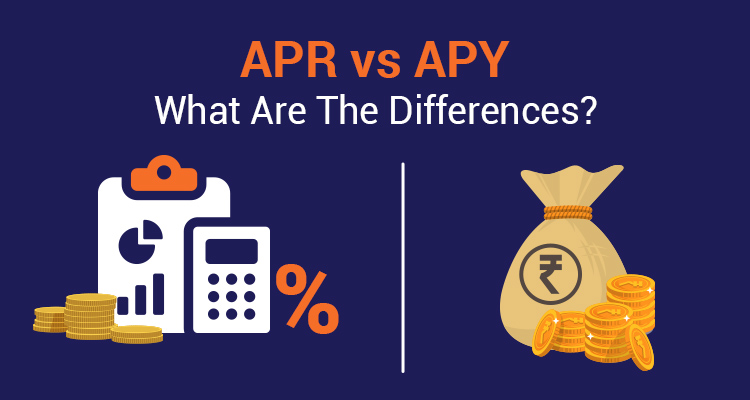APR Vs APY - What's The Differences?

Both APR and APY calculate the interest on the money invested but they are different.
APR or Annual Percentage Rate is linked with interest on money borrowed while APY or Annual Percentage Yield is linked with interest on money saved or accumulated. Let us understand these terms and their differences and understand why they cannot be used interchangeably.
What is APR?
Annual Percentage Rate or APR is the amount of simple interest charged on the credits or borrowings. It also includes any additional fees levied by the lender like processing fees, annual fees, lending fees, loan origination, settlement charges and more. APR does not take into account any compounded interest. APR typically applies on the following credits and borrowings:
- Credit cards
- Home loans
- Car loans
- Personal loans
- Student loans
- Any other loan
By taking into account the APR, a borrower can get an estimate of the true costs of borrowing from various lenders and compare them. This will help the borrower take an educated and a wise decision. The lower the APR, the less the borrower may have to pay as interest for the loan amount borrowed. The APR is calculated using the formula given below:
APR = [((Fees + Interest/Principal)/n) x 365] x 100
Where:
n = the number of days included in the loan term
Principal = the total amount of loan availed
Interest = the total interest payable or paid over the lifetime of the loan
Sapna aapka. Business Loan Humara.
Apply NowWhat is APY?
Annual Percentage Yield or APY is the amount of interest an account can earn in a year. APY takes into account the compounded interest for its calculations. It does not take into account any bonuses that may have been provided. It typically applies to the following accounts:
- Savings accounts
- Money market accounts
- Certificates of deposits
- Fixed deposits
A higher APY reflects a higher rate of return on the investment. The following formula is used for calculating APY:
APY = [(1 + r / n)n] – 1
Where
r = period rate
n = number of compounding periods
APR v/s APY
Let us differentiate between APR and APY on the basis of certain criteria
- Rate of Interest – Since APR implies the amount paid as interest on the borrowed loan amount, the lower interest rate is beneficial.
APY discusses money earned as interest from investments and deposits, therefore, a higher interest rate is beneficial.
- Calculation – APR includes interest rate and additional charges such as processing fees, lending fees, settlement charges etc. It does not factor the compounded interest.
On the other hand, APY mainly takes interest rate and considers the compounded interest in its calculation.
- Variation in rates – Market fluctuations can impact both APR and APY.
Conclusion
While APR measures the amount of interest being paid by the borrower, APY calculates the interest earned on the deposits and investments. The lower APR is better as it implies lower borrowing costs. A higher APY implies a better and higher return on investments. A better understanding of APR and APY is necessary to take a well informed and a wise financial decision.
Whether you need a personal loan, home loan, loan against property, or a business loan, IIFL Finance has you covered. With competitive interest rates, flexible repayment options, and a seamless online application process, applying for loan has never been easier.
Frequently Asked Questions
1. What is a good APR?
There’s no standard range for a good APR. The lower the APR, the less you may have to pay in interest and vice versa.
2. What is a good APY?
Though there is no value to refer to as a good APR but the higher the APY, the more interest you could earn.
Zaroorat aapki. Personal Loan Humara
Apply NowDisclaimer: The information contained in this post is for general information purposes only. IIFL Finance Limited (including its associates and affiliates) ("the Company") assumes no liability or responsibility for any errors or omissions in the contents of this post and under no circumstances shall the Company be liable for any damage, loss, injury or disappointment etc. suffered by any reader. All information in this post is provided "as is", with no guarantee of completeness, accuracy, timeliness or of the results etc. obtained from the use of this information, and without warranty of any kind, express or implied, including, but not limited to warranties of performance, merchantability and fitness for a particular purpose. Given the changing nature of laws, rules and regulations, there may be delays, omissions or inaccuracies in the information contained in this post. The information on this post is provided with the understanding that the Company is not herein engaged in rendering legal, accounting, tax, or other professional advice and services. As such, it should not be used as a substitute for consultation with professional accounting, tax, legal or other competent advisers. This post may contain views and opinions which are those of the authors and do not necessarily reflect the official policy or position of any other agency or organization. This post may also contain links to external websites that are not provided or maintained by or in any way affiliated with the Company and the Company does not guarantee the accuracy, relevance, timeliness, or completeness of any information on these external websites. Any/ all (Gold/ Personal/ Business) loan product specifications and information that maybe stated in this post are subject to change from time to time, readers are advised to reach out to the Company for current specifications of the said (Gold/ Personal/ Business) loan.



